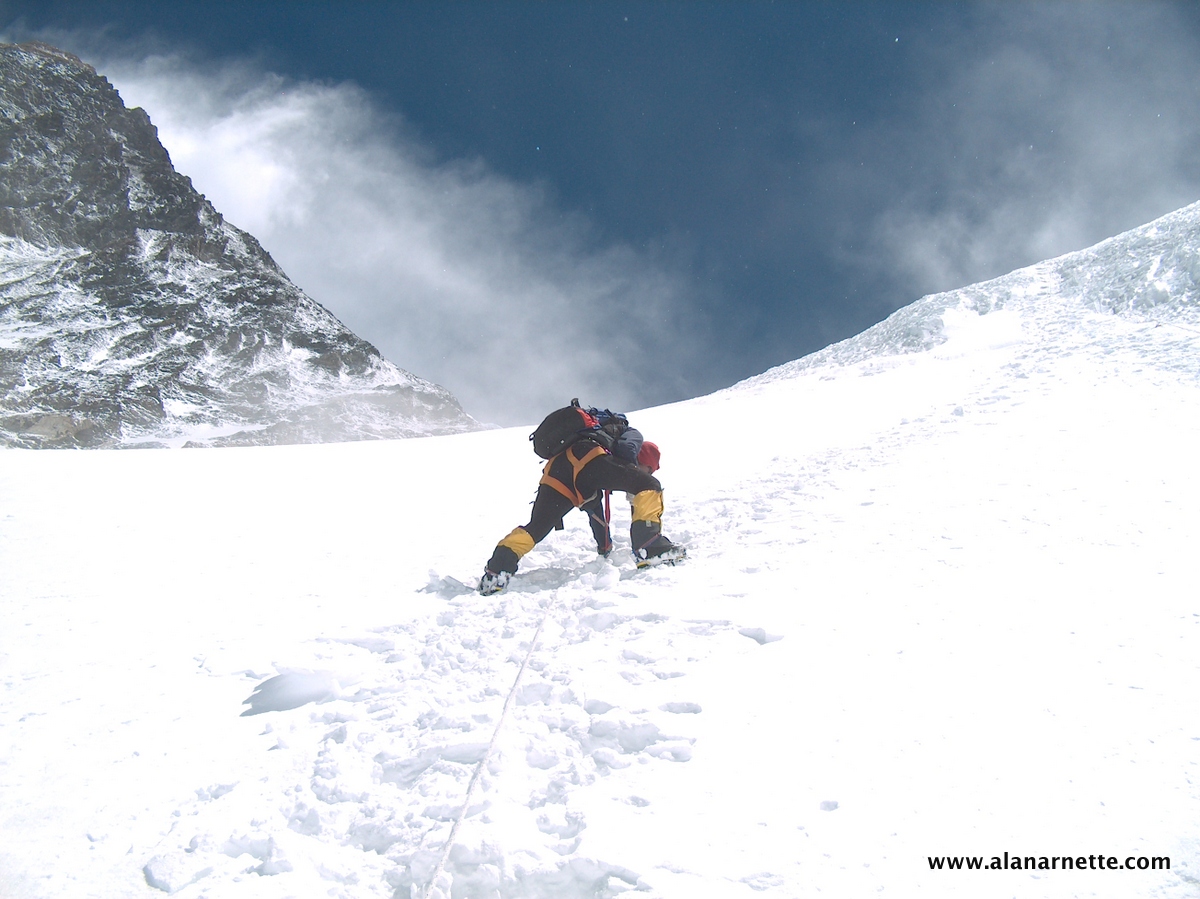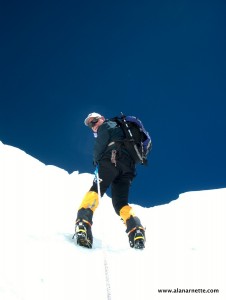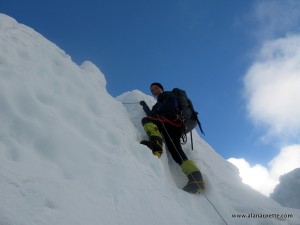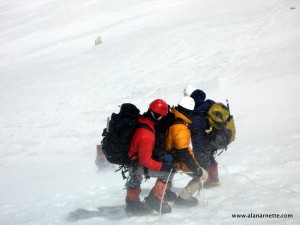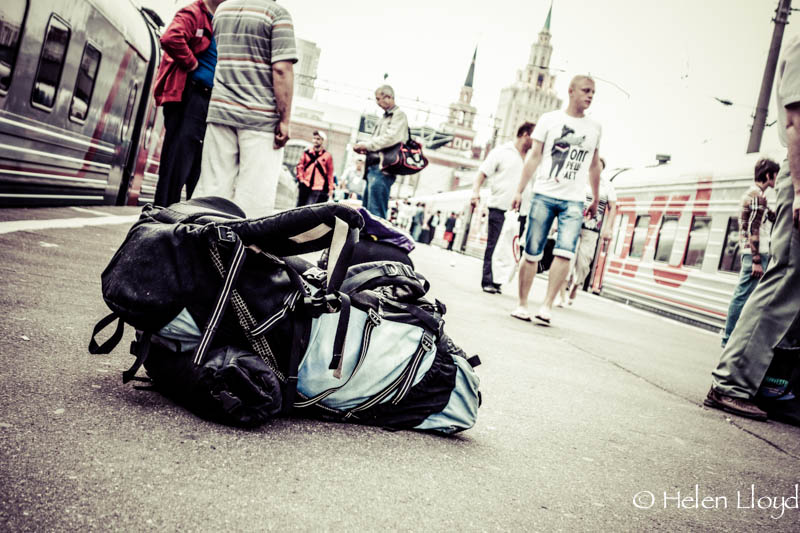The highest mountain in the world, Mount Everest, has been in the news for all the wrong reasons lately. Like this article in Outside for example. My personal interest in the mountain is old. I read Sir Ed Hillary´s book High Adventure The True Story of the First Ascent of Everest as a youngster, I still have a copy of his account. Still a classic. Sir Ed was interviewed in the recently published book The Right Stuff Interviews with Icons of the 1960s by a friend of mine, Jim Clash, a few years back and as regards to Everest today, he said:
“I really haven’t liked the commercialization of mountaineering, particularly of Mount Everest. By paying $65,000, you can be conducted to the summit by a couple of good guides. Clients are spending a large sum of money just to trek up our route, mainly so they can go back home and boast about it. We just wanted to make the first ascent. But, since, it’s become the first Englishman, the first American, the first woman, the first chap to go up backwards. Quite a few of the objectives I would call slightly gimmicky. I mean, they have to think up something that hasn’t been done. Doesn’t matter whether it’s too sensible. If they think they’ll get media coverage, they’ll go ahead and do it.”
These opinions are some of the reasons I took Everest of my bucket list quite a few years ago. I understand people want to climb the highest mountain on earth, but they have to be properly prepared. This week I read a great article on the subject by one of the big name climbers of the mountain, Alan Arnette. I published an article by him earlier regarding the costs to climb Everest, which has had a lot of readers, but I personally also find Alan very responsible and knowledgeable so I asked him if I could re-publish his opinionated article, which I am happy to say he agreed on. (There´s many comments of value as regards to his article on his homepage.)
What Is Wrong With Everest
By
Alan Arnette
Everest is not for the inexperienced, the novice or someone looking for a walk-up. There, I stated the obvious, or did I?
OK, so much for the drama! But as the 2013 season gets closer, I have noticed a few disturbing trends. You would think that after 10 deaths on Everest this spring, the operators would be hypersensitive to qualifying clients, setting expectations and focusing on improving safety.
Most of the deaths had nothing to do with crowds but everything to do with personal responsibility and inexperienced guides.
Setting High Expectations
I recently read Alpenglow‘s promotion for their Spring 2013 Everest expedition. I was quite surprised as their owner, Adrian Ballinger, has been a prominent Everest and Himalayan guide for years so I assume his marketing has just gotten carried away. However, his promotion gives me pause.
He prefaced his promotion for the $85,000 expedition with “our key differences from the other companies working in Nepal, including teams you have perhaps climbed with in the past” then listed many differences with no mention of difficulty, dangers or risks:
- “Pre-acclimatization” by using oxygen tents in the comfort of your home before you arrive
- “remove the discomfort and potential trip-ending health issues of a slow traditional acclimatization through the Khumbu Valley” with helicopter services almost all the way in and out of base camp
- avoid the backbreaking work of carrying a pack, we carry everything for you meaning “you never climb with more than a daypack”
- avoid the “substandard” local food with imported food
- avoid missing surfing the internet, “unlimited wifi internet use in BC”
- In the end “All of this together allows you to take less time away from work or home (only 50 days to climb Mt. Everest or Lhotse), and climb more safely and comfortably.”
Good Lord, is this Everest or Rainier? Actually with these features, Rainier could be harder. Being an experienced operator, I’m sure Alpineglow will vet the clients but his promotion sets all the wrong expectations.
I have been a vocal supporter, advocate and defender of Everest climbers. I recently took the “risk” of writing an article for the October 2012 edition of Rock and Ice, notorious for rock hounds, not alpine lovers, called “In Defense of Everest” (soon to be reposted here). But now, even I have seen my limit with this promotion. Sadly, he will probably get a few clients willing to pay the ridiculous price thinking they can buy their way to the top. This is what is wrong with Everest.
Everest is not a walk-up. There are no shortcuts. You have to put the work in before you arrive. It is hard and people die. Base Camp is not a 5 star hotel. If you come expecting a walk-up, most likely you will take advantage of that helicopter ride out, and not in a good way.
Setting a Low Price
Some of those who die on Everest are often seduced by low price. One case study is David Sharp who paid $6200 for part of a shared north side permit and minimal base camp services. He died alone high on the mountain in 2006.
Another more recent case in point is the 2012 death of Canadian Shriya Shah-Klorfine who climbed with Utmost Adventure Trekking. This is a tragic event and again, I want to express my condolences to her family. However it does serve as a learning aid.
CBCNews has throughly investigated her death, and produced a documentary and this article revealing disturbing actions by both the guide and the climber.
Utmost promotes on their site a 2013 price of $39,270. Not a low price but lacking critical elements others offer at the same price including:
- High Tents above Base Camp.
- High altitude food and fuel above Base Camp.
- Oxygen & Mask and regulator (will be provided as per request).
- Garbage deposit.
These can easily add many thousands to the overall price but also leave the client wanting in serious areas such as adequate oxygen. This is what is wrong with Everest.
As a reference, you can sign on with International Mountain Guides (IMG) for $40,000 which includes generous oxygen to get you to and from the summit, all base camp and high camps food, tents and gear plus a Sherpa who probably has summited at least five times if not, most likely, more than ten.
Hearing what you want to hear
But more disturbing is once again the lack of transparency on dangers. According to the CBC article, the owner of Utmost Adventure Trekking, Ganesh Thakuri, assigned two inexperienced guides for the novice climber, Shriya Shah-Klorfine. This after their most senior guide refused to take her higher than base camp. She died on the descent from the summit after she ran out of oxygen a direct result of climbing too slow and not being turned back by her guides. She even skipped the almost mandatory Camp 3 rotation for standard acclimatization.
After climbing for 19 hours (normal is no more than 12 max) from the South Col to near the summit, Thakuri is quoted as telling her:
“Even if we say you cannot go, you have to go down, strongly. She says like no, I spent money and my goal is to reach to summit. And anyhow I will go. So in this case, we cannot do anything. She refused to turn around, and Thakuri gave her one last bottle of oxygen and let her keep climbing.”
Summit fever is real. I personally know how hard this decision can be given that I have turned myself back three times only 1,800 feet from the summit of Everest. Each time was for different reasons but one overrode all else, the desire to come home safely with or without a summit.
Even with this disaster, Utmost continues to undersell Everest on their website with this information (my emphasis):
Safety is paramount during the course of an expedition, and Utmost Adventure prides itself on its unrivalled safety records. Reaching the summit is one thing, but returning safely is much more important. The Utmost adventure infrastructure is designed to help achieve a good safety record, but this does not mean that accidents cannot occur, Members should be mindful of this. It is important that Members consult, take advice, and act on the advice given by Guides, Sherpas and Staff. Comfort at Base Camp, high sanitation standards, good quality food, reliable radio communications, weather forecasting and Staff training are all obscure but relevant to Members’ safety.
This is what is wrong with Everest.
What Can be Done?
A few ideas:
- Nepal climbing officials set strict standards for who can guide on Everest (today anyone can can call themselves a guide on Everest)
- Expedition operators set extremely high standards before accepting a client; for example, must have climbed an 8000m peak or gone through a formal and difficult “Everest Preparation Climb” on Denali for example (some operators take anyone without regard to experience)
- Climbers, be honest with yourself and save your life, or perhaps someone else’s, gain the experience before going. (self delusion is the greatest killer)
Alan Arnette is a mountaineer, speaker and Alzheimer’s Advocate. He took early retirement from executive level positions with HP after a 30 year career to oversee the care of his mother, Ida, who passed away from Alzheimer’s. In 2011, on behalf of Alzheimer’s causes Alan, at age 54, did something few people have even attempted; he climbed the highest mountain on each continent, including Mt. Everest, in under one year. He shares his experiences through www.alanarnette.com and Outside Magazine with an active following of over 1 million people.
